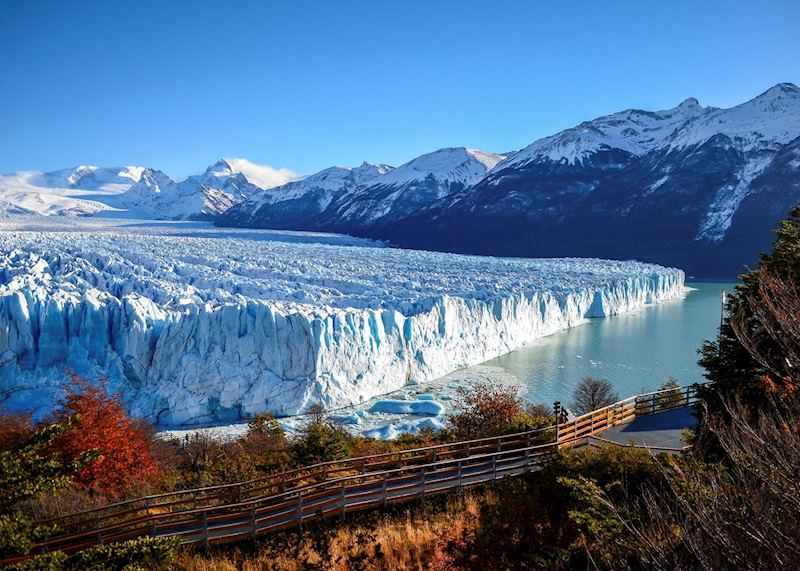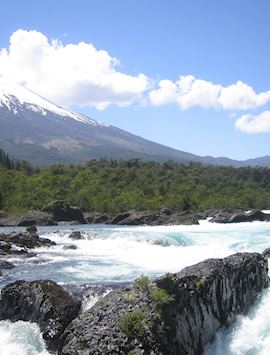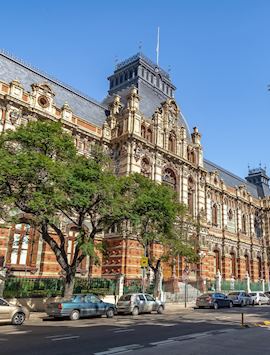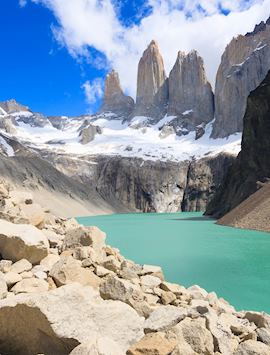By Chile & Argentina specialist Anna
Slipping slowly into the bath-warm waters of a volcanic spring, gazing over towering granite spires from a mountain pass, horse riding with gauchos through the waving grasses of the pampas, or watching Magellanic penguins take part in their own (brutal but beguiling) Fight Club. Chile and Argentina boast distinct, yet equally vivid landscapes, and combining the two countries allows you to delve into them all.
But, there’s a seductively sedate side to these destinations, too. Chile and Argentina offer a slice of the good life, whether you want to revel in the smoky hit of a beautifully succulent steak cooked over a traditional Argentinian parrilla (grill), or sip glass after glass of bold red wines on a vineyard visit.
Why combine Chile & Argentina?
Geographical proximity makes these countries a natural pairing, but so do their flight connections. Overland border crossings (especially in the Lake Districts) are also pleasingly straightforward.
Visiting both allows you to compare and contrast their unspoiled scenery and rich cultures, without taking multiple trips, giving you a deeper appreciation for the region as a whole.
Below, I’ve detailed four of my top ideas for a combined Chile and Argentina holiday, each one geared toward a different passion.

Food & wine highlights of Chile & Argentina
A stay in Buenos Aires kicks off this gastronomist’s tour of both countries, and it’s a fitting start. One of the great culinary hubs of South America, I could spend all day recommending restaurants for you to visit.
If it’s steakhouses you’re after, I’d nudge you towards El Preferido de Palermo rather than the better-known Don Julio. It feels like a laid-back, locals’ restaurant, and it makes for a great first-night dinner. Try its signature dish, Milanesa de carne (breaded beef steaks). I’m also a fan of El Gran Paraíso, a really authentic eatery in La Boca (more on that below).
The next day, you can embark on a tour of the city’s highlights through the lens of food. For example, many people want to visit the rickety, Crayola-bright enclave of La Boca because it’s the birthplace of tango. But, during your time in this district, you can focus on food instead as you watch a traditional asado (barbecue) being prepared while snacking on choripán. This is the city’s take on a sausage sandwich, often slathered with tangy chimichurri sauce. You might also sample ice cream, empanadas, coffee and (perhaps unsurprisingly) a classic Argentine red wine throughout the tour.
Many people aren’t aware of how good Argentina’s cheese is, so I’ll let you in on a secret: go to Palacio Duhau and take their cheese-tasting experience. Here, a cheese sommelier will usher you into a temperature-controlled cellar and lay out their finest specimens for you to try, paired with wines.
Sticking to the wine theme, I recommend flying two hours directly to Mendoza to stay at Cavas Wine Lodge. This is a real retreat, where you can idle over a drink and admire the sunset over the surrounding vineyards from the rooftop bar. Over a couple of days you can take part in tastings and cooking classes.
From one vineyard to another, it’s only a 40-minute flight from Mendoza to Santiago, Chile’s capital. Then travel onward to the Colchagua Valley, my go-to wine region in Chile and a suitable culinary finale to your trip. I suggest staying in Clos Apalta Residence where the tastings are fun and refreshingly unpretentious (no white-gloved staff here), and there are also yoga classes, an infinity pool, and a sundeck.
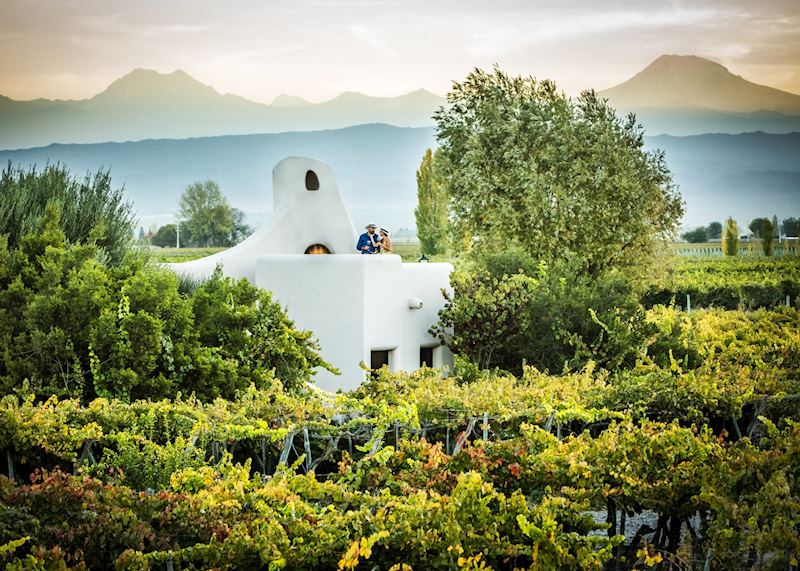
Self-drive trips in Chile & Argentina
Road-tripping is perhaps the easiest, most satisfying way to combine Chile and Argentina in one go. There are many routes to choose from, but I like the ones in the Lake District the best. This region straddles both countries and marks the beginning of Patagonia.
The scenery is rewarding (think the Alps, with a touch of the Great Lakes, plus some volcanoes thrown in for good measure), and the roads are never crowded. You can set your own pace, and you’ll almost always find a spot for a picnic with a view. You also don’t need to be hugely active or interested in hiking in order to feast on the landscapes. They’re all there in front of you, at every bend in the road.
Flying into Santiago, you’ll catch a connection to Puerto Montt in Chile’s Lake District, where you’ll pick up your rental car and drive 30 minutes to Puerto Varas. From this town that lounges on the shores of Lake Llanquihue, you’ll have views onto two conical volcanoes, Osorno and Calbuco. You can unwind by the lakeshore or visit one of the local national parks — I like the temperate rainforest reserve of Alerce Andino, which is laced with walking trails.
From Puerto Varas, you’ll drive five hours and cross the border to reach the lakeside town of Bariloche in Argentina. The town itself is a bit underwhelming, but you’re not here for the urban: leave it behind to drive the Circuito Chico loop, stopping off at viewpoints that give you 360-degree views over isle-scattered Nahuel Huapi Lake and the mountains that hug it. There are also lots of little beaches where you can pull over for a breather.
From Bariloche, it’s around two hours to Villa La Angostura, a town of wooden, Germanic-tinged alpine buildings and chocolate shops. I love the calm that pervades this place. I once spent an afternoon here kayaking across the water (you’re on the northern reaches of Nahuel Huapi Lake) and going ashore to find a quiet nook to read.
Next, pass more mirror-like lakes on the way to San Martín de los Andes, a resort town that has scenic walks and drives (you can find out more in this comprehensive guide to the Argentine Lake District). Crossing back into Chile at Pucón, you have the chance to soak in the hot springs of Villarrica volcano before retracing your steps to Puerto Varas for your onward journey.

Wildlife trips to Chile & Argentina
Wildlife aficionados have to embrace more of a convoluted route when it comes to combining Chile and Argentina, but it’s worth it for the sheer variety and scale of wildlife you’ll potentially get to see.
From Buenos Aires, fly to the Iberá Wetlands, a vast marshland punctuated by outcrops of subtropical forest and latticed with a network of channels and creeks that shelter up to 1,000 species of bird. You can also spot yacaré caimans, capybaras, and howler monkeys here (among many other creatures), and the best way to do it is to stay at Puerto Valle. This converted former estancia (ranch) has a team of high-quality naturalist guides who’ll take you out on the waterways to search for your preferred wildlife sightings.
You have to fly south via the capital to reach the Península Valdés, a scrubby, desert-like, and wind-buffeted nature reserve on the coast of northern Argentinian Patagonia. The main draw here is the southern right whales that breed offshore, and are best viewed between July and November. If you visit during this period you’re virtually guaranteed to see them, and you can often even glimpse them from the beach (or from your hotel’s window, if you’re lucky).
As well as a whale-watching boat trip, I can arrange for you to visit to a remote estancia with a local guide. A short walk from its farmhouse is the world’s largest Magellanic penguin colony. If it’s breeding season (roughly September to March), you can watch from a distance as they battle it out at full throttle, the males using their beaks to bloody each other. Thankfully, I’ve been told it’s not as painful as it looks.
The rest of the day is less dramatic, but still brings potential sightings of southern elephant seals, armadillos, rheas, foxes, and skunks.
From the peninsula, I suggest heading for Torres del Paine, Chile’s headline national park, via the Argentinian town of El Calafate. There are many ways to experience the park, but if you’re looking for a responsible wildlife experience, you can’t get better than the conservation safari offered by Estancia Cerro Guido.
This working estancia-cum-village (it has its own school and gas station) is all about preserving Patagonian culture and ecosystems. During the safari, you’ll head out into the steppe with conservationists who’ve been working with local farmers to encourage them to forgo puma hunting. Instead, they advise them on other means of protecting their sheep and cattle. You’ll also explore puma territory and puma habits using camera-trap technology.
Although you won’t be tracking the animals yourself, which can be damaging to their environment, you still have good chances of glimpsing one before flying home.
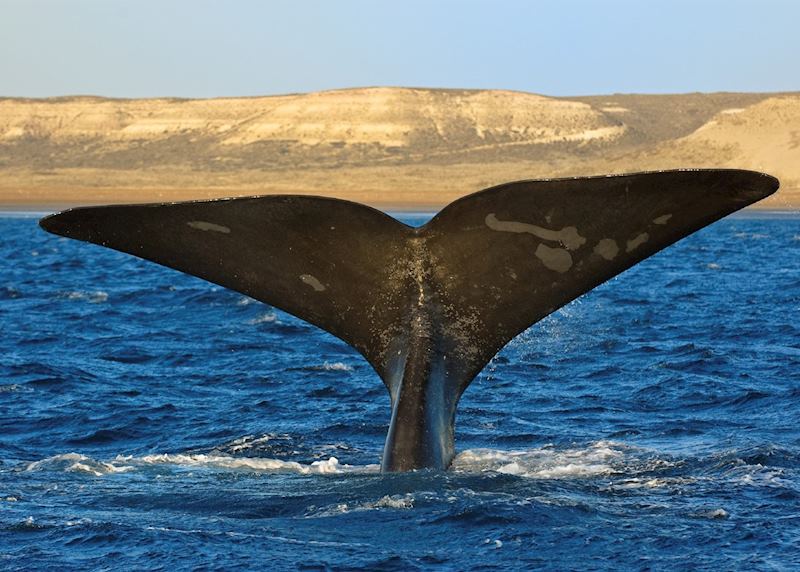
Hiking & adventure in Chile & Argentina
Patagonia heaves with trails, but one stands out as a wish-list item for hikers: the W Trek. It’s a cross-country adventure in Torres del Paine National Park that you can tackle on a guided five- or seven-day route, staying at simple refugios (mountain huts) or campsites.
Words alone can’t do this route justice, but suffice to say you’ll walk through all kinds of thrilling terrain — everything from pampas to native, old-growth lenga forest, and from boulder fields to mountain saddles. You’ll climb to lookouts over glaciers, surreally turquoise lakes, and the three-pronged Torres themselves. You can even bookend your hike with activities like horse riding, rock climbing, and kayaking on Lago Grey.
The Grey Glacier whets your appetite for the next great feat of this trip, when you’ll cross the border to El Calafate to trek on Argentina’s Perito Moreno Glacier.
Being out on the glacier was an incredible experience for me. You really get a sense of its landscapes, of how this immense wedge of ice is sculpted with ice caves and pools, and how it’s a volatile, constantly changing environment. You can actually see routes taken by previous groups, which are now unpassable.
The highlight came when I filled my water bottle with some of the glacial run-off, but then my guide upped the ante by chipping off a piece of ice, and presenting it to me in a glass. He then poured over a tot of whisky. It was probably the best scotch on the rocks I’ve ever tasted.
The adventure then continues in the Lake District, where you can go white-water rafting. Alternatively, fly from El Calafate to Buenos Aires, but escape the city to stay on an estancia. As well as more hiking opportunities, you could even have a go at polo. Estancia stays also offer a restful coda to an active trip — many have lovely pools and spas.
